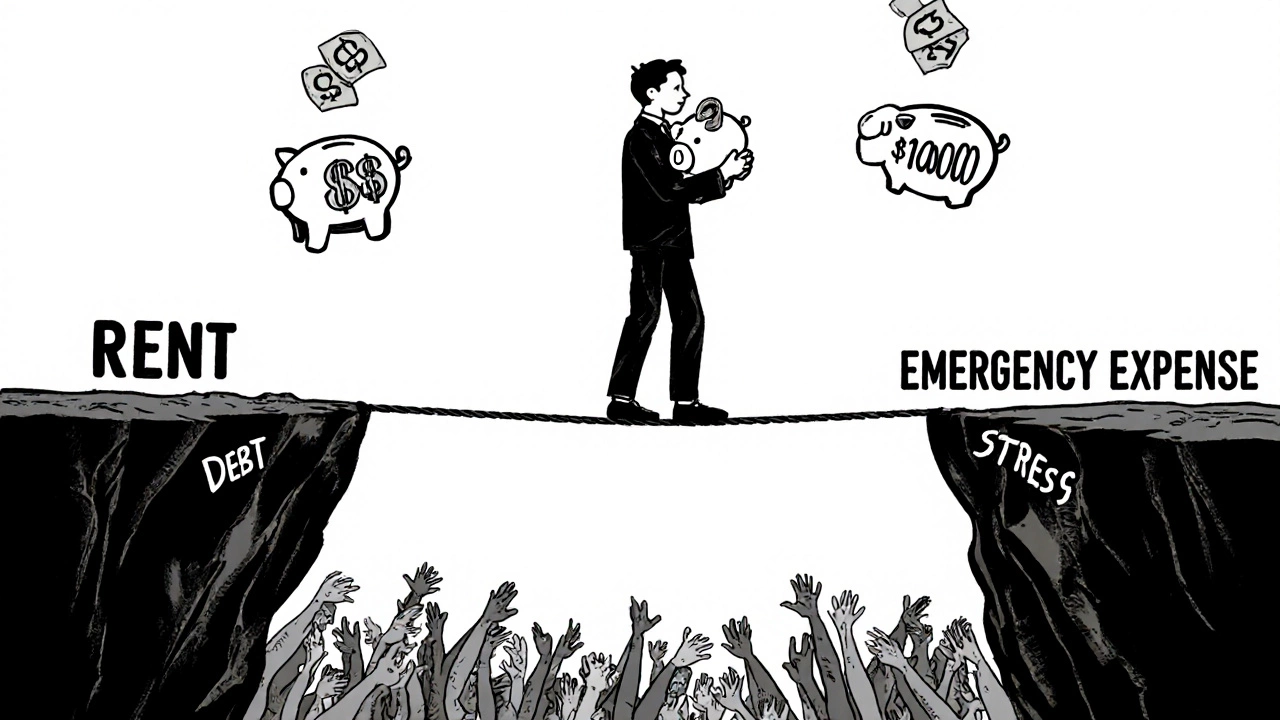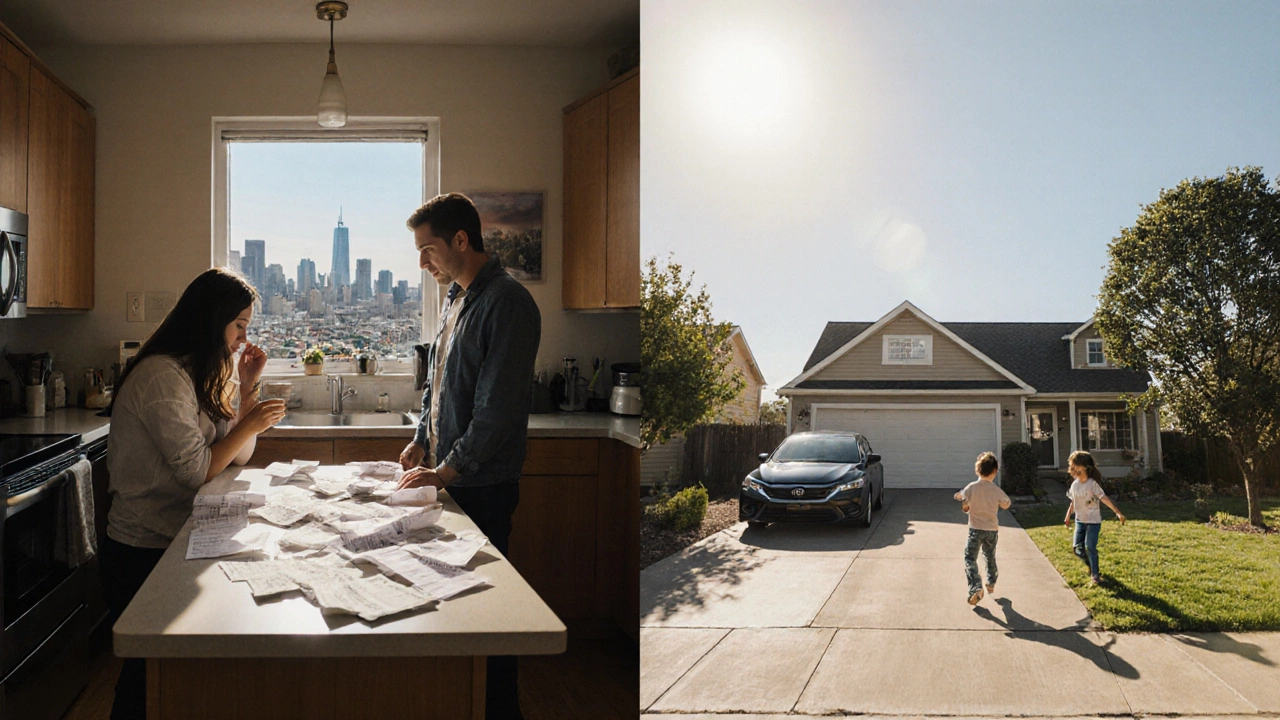Middle Class Income Calculator
Your Situation
Key Expenses
Your Financial Stability Assessment
Your Current Situation
Annual income:
Emergency fund:
Middle Class Requirements
Monthly buffer:
Annual savings goal:
The $1,000 Emergency Test
Can you cover a $1,000 unexpected expense without borrowing or skipping bills? This is the real middle class marker.
What this means for you
When people ask, what income is middle class in 2024, they’re not just looking for a number. They’re trying to figure out if they’re getting by, falling behind, or actually ahead. It’s about rent, groceries, childcare, car payments, and whether a surprise bill will wreck the month. The truth? There’s no single answer. Middle class isn’t a fixed salary. It’s shaped by where you live, how many people are in your home, and what your bills look like.
There’s No National Middle Class Salary
Many websites say the middle class earns between $50,000 and $150,000 a year. That’s misleading. A family making $120,000 in San Francisco is barely scraping by. The same family in rural Mississippi is doing very well. Income alone doesn’t tell the story. Cost of living does.
The U.S. Census Bureau and Pew Research Center use a range based on median household income. In 2024, the national median was about $78,000. Pew defines middle class as households earning two-thirds to double that - so roughly $52,000 to $156,000. But that’s just a starting point. It doesn’t account for taxes, housing, healthcare, or childcare costs that eat up half your paycheck in some places.
What Middle Class Looks Like in High-Cost Cities
In New York City, a two-income household making $140,000 a year might still feel poor. Rent for a modest two-bedroom apartment can cost $3,500 a month. Add utilities, transit, groceries, and childcare - which can run over $1,800 a month - and you’re left with little after taxes. That’s not luxury. That’s survival.
Same in San Francisco, Seattle, or Boston. A single person earning $90,000 might live in a studio apartment and still skip vacations. They’re not rich. They’re just earning enough to avoid homelessness. In these places, middle class doesn’t mean comfort. It means avoiding debt traps.
What Middle Class Looks Like in Lower-Cost Areas
Now flip it. In Oklahoma City, a household making $75,000 can own a three-bedroom house, have two cars, save for college, and take a yearly trip. In rural Georgia or Ohio, $60,000 buys a home outright or with a small mortgage. Childcare? Maybe a grandparent helps. Healthcare? A local clinic. Groceries? Walmart. That’s middle class.
Here, people aren’t wealthy. But they’re stable. They don’t live paycheck to paycheck. They have a buffer. They can fix the car. They can take a sick day without panic. That’s the real marker of middle class - not income, but security.
The Real Middle Class Test: Can You Handle a $1,000 Surprise?
Ask yourself this: If your water heater broke tomorrow, or your kid needed emergency dental work, could you pay $1,000 without borrowing or skipping rent? If yes, you’re likely middle class - even if your income is below the national median.
A 2024 Federal Reserve report found that 38% of U.S. adults couldn’t cover a $1,000 expense. That’s not middle class. That’s one missed paycheck away from crisis. True middle class isn’t about how much you make. It’s about how little you worry.

How Ireland Compares
If you’re in Ireland, the numbers shift. The Central Statistics Office (CSO) says the median household income in 2024 was €64,000. A household earning €50,000-€90,000 is generally considered middle class here. But Dublin changes everything. Rent for a two-bedroom in the city center can hit €2,800. Outside Dublin, €60,000 goes much further.
Healthcare in Ireland is cheaper than the U.S. - but not free. Private health insurance costs €1,200-€2,500 a year. Childcare? Up to €1,000 a month per child. That’s a huge chunk. So even with a higher median income, many Irish families feel the same pressure as Americans.
Why the Middle Class Is Shrinking - Even When Incomes Rise
Wages have gone up since 2020. But so have everything else. Housing prices jumped 40% in five years in many U.S. cities. Childcare costs doubled since 2015. Prescription drugs? Up 60%. College tuition? Still rising.
People think if they get a raise, they’re moving up. But most raises are eaten by inflation. A $5,000 pay bump in 2024 might just cover higher rent. That’s why the middle class feels smaller. More people are working harder, earning more, and still feeling stuck.
What Middle Class Isn’t
It’s not having a nice car. It’s not owning a vacation home. It’s not eating out every weekend. Those are signs of comfort, not stability.
It’s also not being debt-free. Many middle-class families carry student loans, credit card balances, or car payments. The difference? They have a plan. They’re paying down debt, not just making minimums. They’re saving something - even if it’s just $50 a month.

How to Know Where You Stand
Here’s a simple checklist:
- Can you pay your rent/mortgage and bills on time, every month, without using credit?
- Do you have at least $1,000 saved for emergencies?
- Are you contributing to retirement, even if it’s just 5% of your income?
- Can you afford unexpected medical or car repairs without panic?
- Do you have health insurance and a plan for long-term care?
If you answered yes to four or five of these, you’re middle class - no matter the number on your paycheck.
What to Do If You’re Not There Yet
If you’re earning $45,000 and barely making ends meet, don’t feel broken. You’re not alone. The system is stacked. But here’s what helps:
- Track every dollar for 30 days. You’ll find leaks - subscriptions you forgot, impulse buys, overpriced groceries.
- Use free budgeting tools like Mint or YNAB. They don’t cost anything.
- Look for side gigs that fit your schedule - tutoring, dog walking, selling unused stuff.
- Ask about employer benefits. Some companies offer childcare subsidies or student loan help.
- Join a local financial literacy group. Many libraries and nonprofits offer free workshops.
Progress isn’t about becoming rich. It’s about building a buffer. One month, you save $200. The next, $300. Soon, you’re not just surviving. You’re breathing.
Final Thought: Middle Class Is About Control
At its core, being middle class means having control over your life. Not freedom. Not luxury. Control. The power to say no to a job that drains you. The ability to take time off when you’re sick. The peace of mind that your kid won’t go without because you couldn’t afford insulin.
That’s what people are really asking when they wonder: what income is middle class? Not the number. The safety. The dignity. The quiet certainty that tomorrow won’t break you.
Is $100,000 a year middle class in 2024?
It depends on where you live. In cities like New York, San Francisco, or Boston, $100,000 is often just enough to cover rent, taxes, and basic needs - especially with kids. In places like Atlanta, Raleigh, or Omaha, $100,000 puts you comfortably in the upper middle class. The key isn’t the number - it’s your cost of living and financial obligations.
What percentage of Americans are middle class?
According to Pew Research, about 50% of U.S. adults lived in middle-income households in 2024. That’s down from 61% in 1971. The shrinkage comes from more people moving into higher or lower income brackets, not just inflation. Housing and healthcare costs are pushing many out of the middle, while tech and finance jobs pull others up.
Can a single person be middle class on $50,000 a year?
Absolutely - if you live outside a major metro area. In cities like Louisville, Kansas City, or Albuquerque, $50,000 lets you rent a decent apartment, own a car, save a little, and have room for hobbies or travel. In New York or San Francisco, it’s tough. You’d likely need a roommate, live far from work, and cut back on everything. Location matters more than income.
How does inflation affect middle-class income?
Inflation has hit middle-class households harder than most. Wages rose 4-5% in 2023-2024, but rent went up 8%, groceries 7%, and healthcare 9%. That means even if you got a raise, your buying power shrank. Many families didn’t feel richer - they just paid more for the same things. That’s why real income (adjusted for inflation) has barely budged for the middle class since 2020.
Is the middle class disappearing?
It’s not disappearing - it’s splitting. More people are moving into higher-income brackets thanks to tech jobs and remote work. But more are falling into lower-income brackets because housing and healthcare costs are rising faster than wages. The middle is shrinking from both sides. The real threat isn’t poverty - it’s instability. People are working harder, earning more, but feeling less secure than ever.
